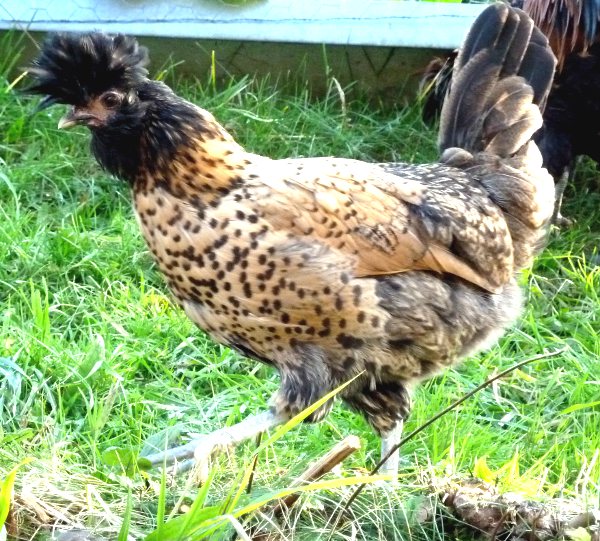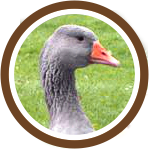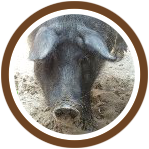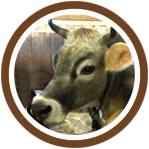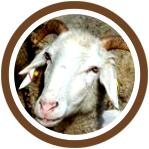Tyrolean chicken
The back-breeding program
For the back-breeding program, selected representatives of various colour varieties of Appenzeller Spitzhauben were paired with likewise selected animals of the extremely rare Polverara chickens. The necessary animal exchange between Italy and Switzerland was approved by the relevant authorities, the veterinary requirements are met. In the offspring, i.e. in the "New Tyrolean" two things stood out:
- Although the different color varieties have been bred to each other (to obtain the broadest possible genetic basis) outweighs black color with the offspring (even in matings whiteXwhite). Some strains developed then in the phase of pullets and cockerels a magnificent plumage (see below).
- The offspring seems to inherit the mind of the sedate Polveraras: flying little and hardly nervous. They can be caught and picked up easily and are therefore suitable for Ark Farms with numerous children. Even between cocks, there is little aggression.
=> Those wishing to participate in the project and take a breeding group, address oneself to the contact persons listed under contacts. Animals or hatching eggs will be delivered only in the former distribution area.
Attention, the project works with a "closed herdbook". The parentage is recorded in this. This is to keep the breeding clean from crossbreeding. All animals that are not included in the herdbook are therefore considered to be crested chickens, but not Tyrolean chickens.
Please note: The delivery of the new Tyrolean should not interfere with the conservation breeding of endangered local breeds!
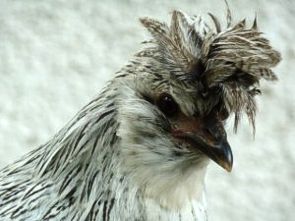

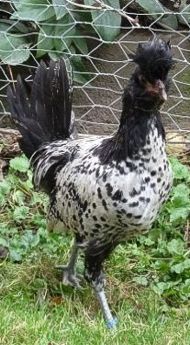
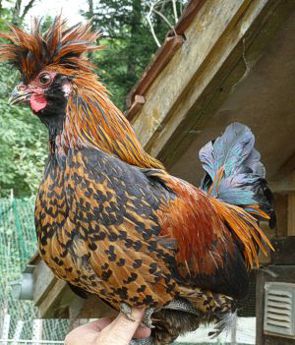
Nachzucht 2012: oben Junghennen, unten Junghähne
Characterization of New Tyrolean
Designations
Neu-Tirolerhuhn, Tirolerhuhn, Gallina Tirolese (ita)
Area of origin
Territory of the former Austrian Empire, the provinces of Bolzano and Trento (IT), Tyrol, Salzburg and Vorarlberg (A), Central and Eastern Switzerland (CH), South German border area in Bavaria (Germany).
Type and productive orientation
Elegant and sturdy chicken of medium height, very attractive and forward facing pointed hood (bonnet), well-developed beard. The chickens have a well-developed brood drive. Attitude in general on family farms with extensive free-range (pasture), dual-purpose chicken meat and eggs (about 52-58 grams). The meat is lean and of fine flavor.
Biometric data
| Average weight of mature cock: | 2,0 – 2,4 kg |
| Average weight of mature hen: | 1,5 – 1,8 kg |
| Egg: | 52 – 58 g, Minimum Weight: 50 g |
| Color of the egg shell: | pure white and whitish |
| Laying performance: | 160 – 200 eggs / year |
| Size of the base ring: | 18 mm cock, hen 16 mm |
Typical characteristics
- Body: cylindrical, medium length, well rounded.
- Head: compact, of medium height, hood facing forward.
- Beak: strong and slightly curved, of a greyish to bluish-black color
- Eyes: large, lively, bright and red-orange to brown in color
- Crest: small V-shaped horns comb.
- Wattles: small and red.
- Face: red.
- Ear shells: Medium size, oval and white-bluish color.
- Beard: Beard and whiskers often black, wattles and ear cups cover only partially.
- Hood: Always well developed and directed forward.
With cocks: high and narrow; with hens: full (wide) and smaller. - Neck: upright, often with black ruff. Cock: long, arched and carried erect; with long and fine feathers. Hen: rather short and curved.
- Shoulders: average wide.
- Back: average length and width; lowered the tail.
- Wings: worn close to the body.
- Tail: carried upright, even with the hen.
- Chest: little projecting, carried high.
- Legs: medium long, conspicuous and not feathered, blue to slate-green, four toes.
- Belly: well developed, soft.
- Skin: pale, white
- Structure of the plumage: close fitting, long, rounded feathers.
- Coloring of the plumage: all colors.
Morphological, biometric and color characteristics which lead to exclusion
- To squat or upright posture;
- Feeble hull;
- Open, falling apart, crooked or rear-facing hood
- Not sufficiently well-developed beard;
- Of the characteristic differing body mass and weight.
Color varieties
In the Tyrolean chickens there were different color varieties, the black color predominated.
With the New Tyroleans the black colour also dominates, but there are also several colour variants. Apart from the black colouring, however, no other colourings will be bred. The breeders want a "colourful farm mix".
